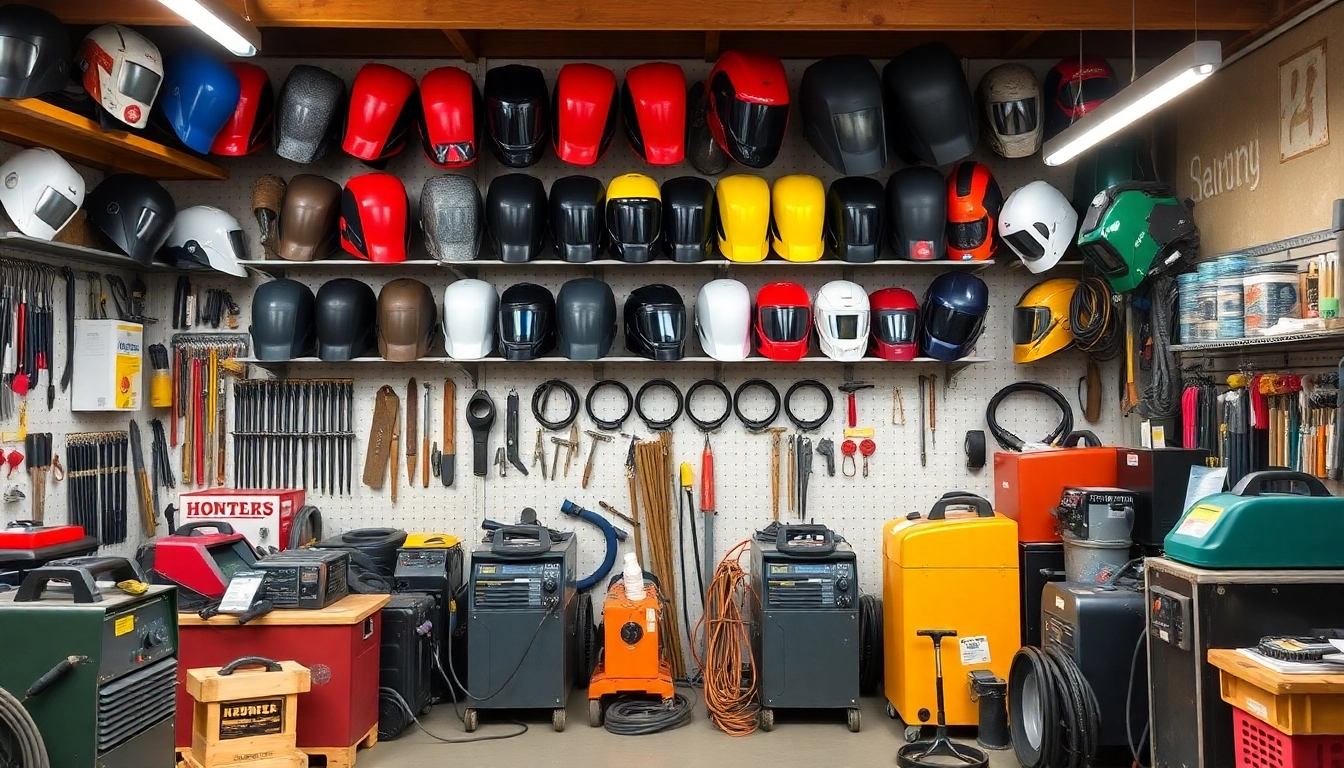Understanding Welding Supplies: An Overview
Welding is a fundamental technique integral to various industries, from manufacturing to construction. A critical aspect that ensures quality and safety in welding processes is the equipment used—this encompasses a wide range of welding supplies, which are vital for each job’s success. Understanding welding supplies means recognizing their significance and how different types can enhance the effectiveness of a welding project.
What Are Welding Supplies?
Welding supplies refer to all materials and tools required to conduct welding tasks effectively and safely. This includes a variety of items ranging from welding machines and protective gear to fillers and consumables. Each supply plays a role in ensuring that the welding process runs smoothly and yields optimal results. Common supplies include:
- Welding Machines: Devices that provide the necessary heat and energy for welding.
- Welding Electrode: Material that provides filler metal during the welding process.
- Protective Gear: Equipment aimed at ensuring the welder’s safety, such as helmets, gloves, and jackets.
- Welding Fume Extractors: Tools designed to remove harmful fumes generated during welding.
The Importance of Quality in Welding Supplies
Quality in welding supplies cannot be overstated. High-quality materials ensure:
- Durability: Products that withstand the rigors of heavy-duty use are essential in industrial applications.
- Safety: Prevents accidents and injuries, maintaining a safe working environment.
- Efficiency: Quality supplies often work better and integrate more smoothly, leading to less downtime and increased productivity.
- Cost-Effectiveness: While the initial investment might be higher, high-quality supplies often reduce the long-term costs due to less frequent replacements and fewer repairs.
Different Types of Welding Supplies Available
Depending on the application and welding process, there are various types of welding supplies to consider:
- MIG Welding Supplies: For Metal Inert Gas welding, commonly includes welding wires and gas.
- TIG Welding Supplies: For Tungsten Inert Gas welding, needs specific rods, gas, and equipment for processes including orbital welding.
- Stick Welding Supplies: Includes electrodes and cables used for manual arc welding.
- Plasma Cutting Supplies: Equipment for cutting through electrically conductive materials.
Essential Welding Equipment for Beginners
If you’re new to welding, it’s crucial to have the right set of basic equipment to get started efficiently. Beginners should invest in essential tools that can support their initial forays into welding.
Must-Have Welding Supplies for New Welders
New welders should consider the following essential supplies:
- Workbench: A solid, flat workbench that can withstand heavy items and is at a comfortable height for you to work on.
- Welding Helmet: Automatic darkening welding helmets are advisable for protection against harmful light and radiation.
- Welding Gloves: High-quality gloves to protect hands from heat and molten metal.
- Welding Jacket: Flame-resistant jackets to safeguard clothing and skin.
- Welding Clamp: To secure workpieces together for more accuracy.
- Safety Glasses: To protect your eyes from flying debris and UV rays.
Safety Equipment: Protecting Yourself
Safety in welding cannot be compromised. Beyond the basic welding gear, additional safety supplies include:
- Respirators: To protect against inhalation of hazardous fumes.
- Earmuffs: Protect your hearing from the loud noise produced by welding machines.
- Aprons: To shield clothing and body from sparks and heat.
- Safety Boots: Steel-toe boots provide essential protection for your feet.
Common Challenges When Starting with Welding Supplies
As a novice, you may encounter various challenges, such as:
- Choosing the Right Equipment: Selecting welding supplies that are appropriate for your specific project can be overwhelming.
- Understanding Techniques: Learning proper welding techniques takes time and practice.
- Troubleshooting Issues: New welders may struggle with equipment issues or welding defects that require immediate resolution.
Advanced Welding Supplies for Professionals
Once you’ve mastered the basics, it’s time to consider advanced equipment that can enhance your welding capabilities and efficiency.
High-End Welding Machines: What You Need to Know
Professional welders can benefit greatly from investing in high-end machines. Key factors to consider include:
- Power Range: Choose machines with adjustable amperages that suit various materials and thicknesses.
- Portability: For those who work on-site, select welders that are easy to transport.
- Multi-Process Capability: Certain machines can perform MIG, TIG, and stick welding, providing versatility.
- Brand Reliability: Trusted brands provide superior customer service and warranty options—critical for professional usage.
Specialized Tools for Different Welding Techniques
Different welding techniques require specialized tools:
- TIG Welding: Use tungsten electrodes, gas regulators, and high-frequency starters.
- MIG Welding: Employ rollers and specific wire feeders for optimal performance.
- Stick Welding: Choose appropriate electrode holders and cable setups.
- Plasma Cutting: Necessary accessories, including nozzles, electrodes, and consumable parts.
Performance Metrics for Professional-Grade Supplies
When investing in advanced welding supplies, consider performance metrics such as:
- Duty Cycle: The percentage of time the welder can operate in a given period without overheating.
- Efficiency Ratings: Measure how effectively a machine converts input power into usable output.
- Quality of Output: Inspects the quality and strength of welds produced.
Cost-Effective Solutions for Purchasing Welding Supplies
Purchasing welding supplies can incur significant costs. Fortunately, there are strategies that can help mitigate expenses while ensuring quality.
Where to Buy Affordable Welding Supplies
Various options are available for purchasing welding supplies:
- Local Stores: Often provide in-person assistance and immediate access to products.
- Online Retailers: Websites like Amazon and specialized welding supply stores often feature competitive pricing.
- Discount Suppliers: Look for non-mainstream suppliers that offer discounts on high-quality items.
- Used Equipment Shops: Consider reputable second-hand stores for budget-friendly options.
Understanding Price Ranges for Different Equipment
Price ranges can vary greatly depending on the quality and brand. For example:
- Entry-Level Welders: Typically range from $200 to $800.
- Mid-Range Equipment: Costs around $800 to $2,000, featuring more robust capabilities and better performance.
- Professional Units: Can surpass $2,000, catering to advanced applications and heavier-duty use.
Maximizing Value through Bulk Purchases
Strategies to maximize value include:
- Buying in Bulk: Purchasing higher quantities can lead to discounts.
- Subscription Services: Some stores offer subscriptions for necessary supplies at discounted rates.
- Seasonal Sales: Taking advantage of holiday or end-of-year sales for major purchases.
Maintaining and Caring for Your Welding Supplies
Proper maintenance of welding supplies extends their lifespan and ensures optimal performance. Understanding how to care for your equipment is crucial.
Best Practices for Storing Welding Supplies
Consider these best practices for storage:
- Climate Control: Store equipment away from extreme temperatures and humidity to prevent damage.
- Organized Storage: Utilizing racks and bins can help keep tools accessible and preserve their condition.
- Regular Checks: Perform inventory audits periodically to catch damaged supplies early.
Regular Maintenance Tips for Longevity
To maintain welding equipment, implement the following strategies:
- Clean Equipment: Removal of spatter and dirt enhances performance in all welding processes.
- Check for Wear and Tear: Inspect cables, hoses, and other components routinely for signs of wear.
- Updating Consumables: Maintain a stock of necessary consumables to avoid delays in projects.
Signs It’s Time to Replace Your Welding Supplies
Understanding when to replace equipment is vital for safety and efficiency:
- Common Wear Issues: Look for significant rust, cracking, or burning of components.
- Performance Drops: If equipment scores lower on performance metrics or causes frequent problems, it may need replacement.
- Outdated Technology: Upgrading to more effective or efficient models can provide long-term benefits.



